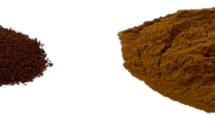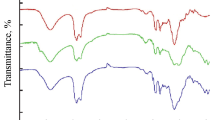Abstract
Conventionally bisphenol A epichlorohydrin (BPA-EC) is used as epoxy resin and cycloaliphatic amine is used as a curing agent for industrial corrosion mitigation. However, due to their noticeable toxicity, alternative curing agents and decreasing the conventional compounds in the coating is a demanding task. Aminopropyltriethoxysilane can be an alternative curing agent and lignin can partially replace BPA-EC , as the preliminary adhesion study of the developed coating suggested. However, other characteristics of the coating need to be examined to evaluate the coating holistically. Hydrophobicity is such a characteristic, which plays a leading role in enhancing the anti-corrosivity of the coating, especially for coating, implemented on submerged metallic bodies. The current study attempted to find the justification of BPA-EC in terms of hydrophobicity. The response surface methodology has been followed using the Box–Behnken design model to investigate the respective and cumulative effect of each element. Initially, the model has a P value of 0.0198, with some of the terms not significant. Thus, a modified model has been introduced keeping only the terms, close to the significant p-value of 0.05. Finally, a P-value of 0.0001 has been achieved. Experimental verification of the response values exhibited an average error of 9.84%. The result showed a non-linear association between the respective constituents. Statistics showed that BPA-EC positively impacts hydrophobicity. Thus, to maintain the hydrophobicity rather than 100% replacement by lignin, a minimum level of bisphenol epichlorohydrin is obligatory; ensuring the legitimacy of the constituents in the coating.









Similar content being viewed by others
Abbreviations
- APTES:
-
Aminopropyltriethoxysilane
- BBD:
-
Box–Behnken design
- BPA-EC:
-
Bisphenol A epichlorohydrin
- EDX:
-
Energy dispersive X-ray analysis
- FESEM:
-
Field emission scanning electron microscopy
- OM:
-
Oncorhynchus mykiss
- RSM:
-
Response surface method
References
ASTM D5946 (2017). Available at: https://www.astm.org/d5946-17.html.
BASF (2022). Available at: https://download.basf.com/p1/000000000030516237_SDS_CPA_TH/en_TH/Sharpen_000000000030516237_SDS_CPA_TH_en_1-0.pdf.
Beeram PSR, Waldman RM, Hu H (2017) ‘Measurements of ice adhesion over ice mitigation coatings pertinent to aircraft icing and anti-/de-icing’, In: 9th AIAA Atmospheric and space environments conference, p. 3928.
Behin J et al (2018) Enhancing mechanical properties of epoxy resin using waste lignin and salicylate alumoxane nanoparticles. Korean J Chem Eng 35(2):602–612. https://doi.org/10.1007/s11814-017-0301-0
buchler SAFETY DATA SHEET (2021). Available at: https://www.buehler.com/assets/SDS/UK/1350306_E_EpoxiCure-2-Resin_EN.PDF.
Carlos de Haro J et al (2019) Lignin-based anticorrosion coatings for the protection of aluminum surfaces. ACS Sustain Chem Eng 7(6):6213–6222. https://doi.org/10.1021/acssuschemeng.8b06568
Castagna M et al. (2018) ‘An isotropic porous medium approach to drag mitigation disappearance in super-hydrophobic falling spheres’, arXiv preprint arXiv:1810.09765 [Preprint]
Chen L et al (2023) Open water characteristics of marine propeller with superhydrophobic surfaces. Ocean Eng 269:113440
COPPS (2018). Available at: https://www.coppsindustries.com/wp-content/uploads/K-505-SDS.pdf
Devadasu S et al (2021) Development of ultra-high build self-healing coatings using amino silanized lignin nanocapsules. Mater Today: Proc 45:5745–5751. https://doi.org/10.1016/j.matpr.2021.02.576
Feldman D et al (1991) Structure–properties relations of thermally cured epoxy–lignin polyblends. J Appl Polym Sci 42(6):1537–1550. https://doi.org/10.1002/app.1991.070420607
Figueira RB et al (2016) Hybrid sol-gel coatings: Smart and green materials for corrosion mitigation. Coatings 6(1):12
Geyer F et al (2020) When and how self-cleaning of superhydrophobic surfaces works. Sci Adv 6(3):eaaw 9727
Hao C et al (2019) A high-lignin-content, removable, and glycol-assisted repairable coating based on dynamic covalent bonds. Chemsuschem 12(5):1049–1058. https://doi.org/10.1002/cssc.201802615
Henn KA et al (2021) Colloidal lignin particles and epoxies for bio-based, durable, and multiresistant nanostructured coatings. ACS Appl Mater Interfaces 13(29):34793–34806. https://doi.org/10.1021/acsami.1c06087
Hult E-L et al (2013) Enhancing the barrier properties of paper board by a novel lignin coating. Ind Crops Prod 50:694–700. https://doi.org/10.1016/j.indcrop.2013.08.013
Liu X et al (2021) Optimization of thermal and hydrophobic properties of GO-doped epoxy nanocomposite coatings. Nanotechnol Rev 10(1):1236–1252. https://doi.org/10.1515/ntrev-2021-0078
Liu X et al (2022) Effect of functional group and structure on hydrophobic properties of environment-friendly lignin-based composite coatings. Int J Biol Macromol 215:132–140. https://doi.org/10.1016/j.ijbiomac.2022.06.055
MAPIE (2023). Available at: https://cdnmedia.mapei.com/docs/librariesprovider12/products-documents/2_90589990_en_55295c0bd97a416c85c451489431121f.pdf?sfvrsn=9c653081_0
Oldani V et al (2016) Perfluoropolyethers coatings design for fouling reduction on heat transfer stainless-steel surfaces. Heat Transfer Eng 37(2):210–219
Pan H et al (2022) Performance of a propeller coated with hydrophobic material. J Mar Sci Eng 10(2):236
Park Y, Doherty WOS, Halley PJ (2008) Developing lignin-based resin coatings and composites. Ind Crops Prod 27(2):163–167. https://doi.org/10.1016/j.indcrop.2007.07.021
Park KH et al (2017) Advances in medical adhesives inspired by aquatic organisms’ adhesion. Biomater Res 21(1):16. https://doi.org/10.1186/s40824-017-0101-y
Sugama T, Cook M (2000) Poly (itaconic acid)-modified chitosan coatings for mitigating corrosion of aluminum substrates. Prog Org Coat 38(2):79–87
Wang Z, Lin S (2017) Membrane fouling and wetting in membrane distillation and their mitigation by novel membranes with special wettability. Water Res 112:38–47
Wang Y et al (2021) Preparation and self-cleaning performance of carbon-based superhydrophobic coatings based on non-fluorine and non-toxic corn straw. Molecules. https://doi.org/10.3390/molecules26216401
Wang X et al (2022) Anticorrosive epoxy coatings from direct epoxidation of bioethanol fractionated lignin. Int J Biol Macromol 221:268–277. https://doi.org/10.1016/j.ijbiomac.2022.08.177
Zhang Z et al (2021) An experimental study on the detrimental effects of deicing fluids on the performance of icephobic coatings for aircraft icing mitigation. Aerosp Sci Technol 119:107090
Zhang B et al (2022) Eco-friendly anticorrosion superhydrophobic Al2O3@PDMS coating with salt deliquescence self-coalescence behaviors under high atmospheric humidity. Front Mater. https://doi.org/10.3389/fmats.2022.839948
Acknowledgements
The authors would like to thank the UTP Centre for Corrosion Research, especially the staff, and colleagues, for their invaluable technical support throughout this research endeavor. The contribution of Dr. Mazli bin Mustapha in deriving the outcomes of the statistical results is highly noteworthy. Furthermore, the organization of this work by Universiti Teknologi PETRONAS is deeply appreciated. Lastly, the authors are grateful to Allah (swt) for granting success to this endeavor.
Funding
The work was supported by the grant (Grant Code: 015MD0-104) of the collaborative research project between Sarawak Energy Berhad, Malaysia, and Universiti Teknologi Petronas, Malaysia. Universiti Teknologi Petronas has organized the research facilities and consultancies for the research.
Author information
Authors and Affiliations
Contributions
NEC: Writing—original draft, Methodology, Software. PSMBMY & MBM: Supervision, Conceptualization. NFBCL: Formal analysis, Investigation.
Corresponding author
Ethics declarations
Conflict of interest
The authors have stated that there are no conflicts of interest regarding the research, authorship, and publication of this article.
Ethical approval
The authors declare that they have no conflict of interest in the presented work.
Additional information
Editorial responsibility: Fatih ŞEN.
Rights and permissions
Springer Nature or its licensor (e.g. a society or other partner) holds exclusive rights to this article under a publishing agreement with the author(s) or other rightsholder(s); author self-archiving of the accepted manuscript version of this article is solely governed by the terms of such publishing agreement and applicable law.
About this article
Cite this article
Chowdhury, N.E., Bt Megat Yusoff, P.S.M., B Mustapha, M. et al. Investigating the influence of the composition of the modified lignin-epoxy coating on hydrophobicity, using Box–Behnken design optimization model. Int. J. Environ. Sci. Technol. 21, 7237–7248 (2024). https://doi.org/10.1007/s13762-024-05461-7
Received:
Revised:
Accepted:
Published:
Issue Date:
DOI: https://doi.org/10.1007/s13762-024-05461-7




